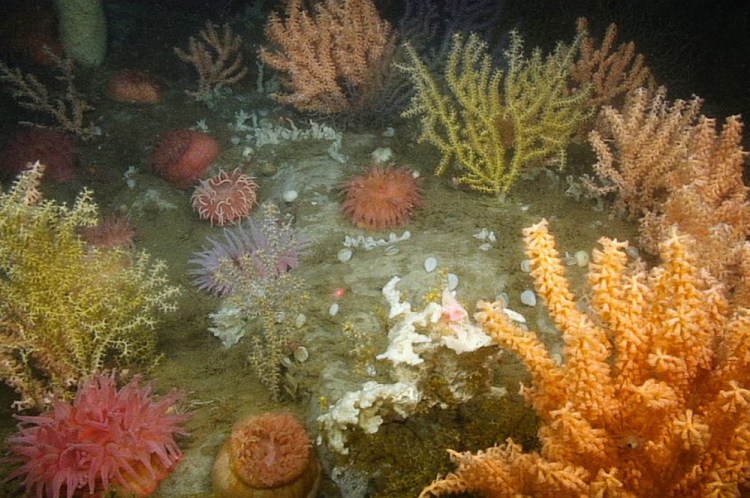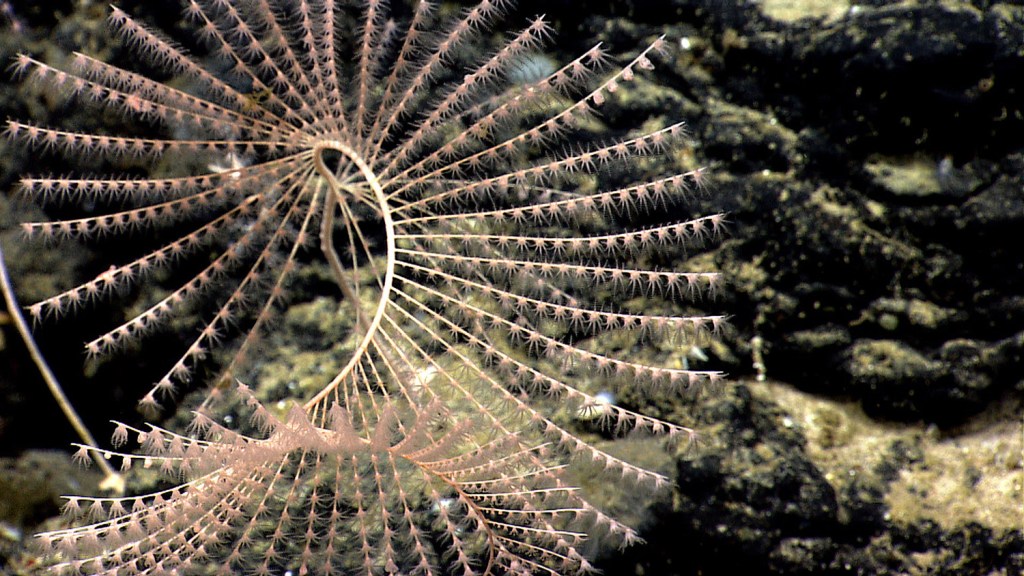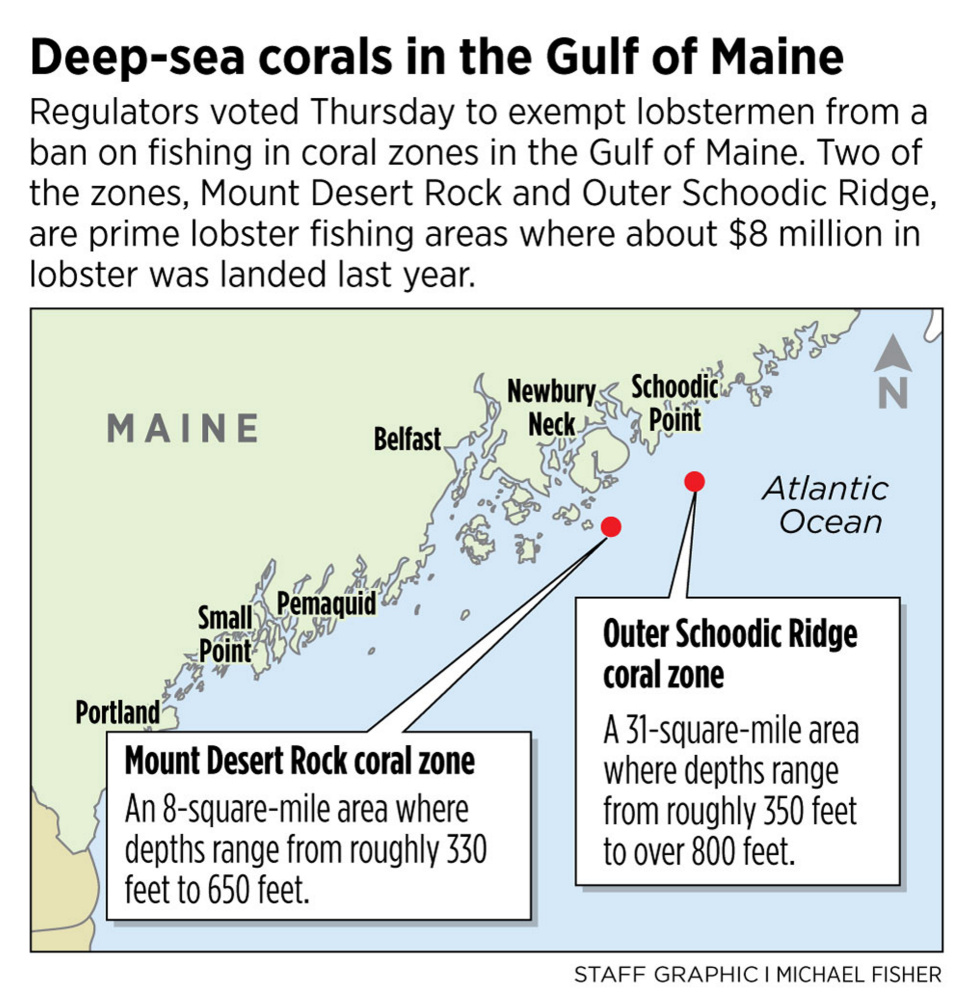A deep-sea coral protection plan adopted Thursday won’t keep Maine fishermen out of their traditional Gulf of Maine fishing spots.
The New England Fisheries Management Council voted to ban all but lobstermen from fishing about 39 square miles of coral-rich area in two protection zones near Mt. Desert Rock and Outer Schoodic Ridge. About 50 Maine lobster boats from more than a dozen ports harvest more than $8 million worth of lobster from those areas, according to state estimates.
Marine Resources Commissioner Pat Keliher called the coral protection plan a good compromise.
“The Gulf of Maine coral motion is one I helped perfect,” Keliher said. “It gives adequate protection to the corals in certain areas of the Gulf of Maine and it exempts lobster gear, which has a lot of landed value and really a very low impact to the corals. We think it’s a good balance. … I would rather take a bite of the apple here one bite at a time instead of trying to do it all.”
Keliher noted that most fishermen avoid corals “like the plague” because it destroys their gear and costs them money.
Lobstermen turned out in big numbers at some of the public hearings on these proposed coral zones, but their anxiety faded once the council decided to choose a proposal that would allow lobster fishing in these areas as the preferred option. The council could have reversed course, but such a turnaround is rare for a board that works so closely with the fishing industry.
Ground fishermen say the exclusion from the Mt. Desert Rock and Outer Schoodic Ridge coral protection zones doesn’t hurt them.
“We haven’t been able to fish there in so long because it’s completely plugged up with lobster traps,” said Maggie Raymond, the head of the Associated Fisheries of Maine. “It’s one of the reasons we didn’t want to lose the offshore area, because once you close it to groundfishing it immediately gets usurped by lobster traps. Getting back in there is very difficult to do.”
The eight captains that Raymond represents – who live in Maine but land fish in Massachusetts – did not mind giving up those waters because the council scuttled its plan to establish offshore coral zones in about 67 square miles of Jordan Basin, a popular groundfishing area that sits on the international boundary line, and Lindenkohl Knoll, a 44-square-mile area about 25 miles northwest of Georges Bank.
Offshore lobstermen drop their traps in these deep waters, but Maine fishing boats also use gillnets and trawls to fish for pollock, redfish and white hake in these scattered zones that had been under consideration for protection. Council staff value the fisheries here at about $500,000. Divers have found some lush coral gardens here, but much of it remains unmapped.
The council voted to allow scientists to study the impact of fishing gear on corals in a 103-mile zone in Jordan Basin, but at this time, there is no research funding set aside to even map out this area of the ocean floor, much less provide documentation of whether it is covered in coral, or what fishing gear might be doing to it, council staffers said.
The council wants to protect the rare, slow-growing gardens of deep-sea sea whips, fans and pens as essential habitat for cod, silver hake, pollock and larval redfish. Although it adopted the Gulf of Maine zones Thursday, it postponed a vote on broad coral zones in southern New England until it could study a proposal from environmental groups to expand the zone in to shallower waters.
There also could be deep-water corals in other parts of the gulf that scientists do not know about yet. The council could always add areas, or change the protection measures, in the future if researchers find more corals as they continue mapping out these relatively unexplored areas, or find conclusive evidence that lobster pots or other allowed gear is harming the coral.
University of Connecticut marine science professor Peter Auster has led two expeditions that used remotely operated underwater vehicles to photograph and sample these Gulf of Maine coral zones. Researchers have found evidence of the damage that fishing has inflicted on these habitats, including scarring on the ocean bottom from nets dragged along the basins, Auster said.
While trawling may cause the most damage, lobster pots can get in the rocky crevices where coral thrives and crush the coral or rip it right off the rock, Auster said.
But many fishermen who work in these areas say they have never found coral in their lobster traps. They note that coral appears to be thriving in these areas despite centuries of heavy fishing.
Penelope Overton can be contacted at 791-6463 or at:
poverton@pressherald.com
twitter: PLOvertonPPH
Copy the Story LinkSend questions/comments to the editors.






Success. Please wait for the page to reload. If the page does not reload within 5 seconds, please refresh the page.
Enter your email and password to access comments.
Hi, to comment on stories you must . This profile is in addition to your subscription and website login.
Already have a commenting profile? .
Invalid username/password.
Please check your email to confirm and complete your registration.
Only subscribers are eligible to post comments. Please subscribe or login first for digital access. Here’s why.
Use the form below to reset your password. When you've submitted your account email, we will send an email with a reset code.